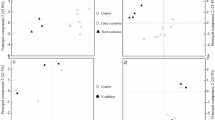Abstract
Fatty acid methyl ester (FAME) profiles, together with Biolog substrate utilization patterns, were used in conjunction with measurements of other soil chemical and microbiological properties to describe differences in soil microbial communities induced by increased salinity and alkalinity in grass/legume pastures at three sites in SE South Australia. Total ester-linked FAMEs (EL-FAMEs) and phospholipid-linked FAMEs (PL-FAMEs), were also compared for their ability to detect differences between the soil microbial communities. The level of salinity and alkalinity in affected areas of the pastures showed seasonal variation, being greater in summer than in winter. At the time of sampling for the chemical and microbiological measurements (winter) only the affected soil at site 1 was significantly saline. The affected soils at all three sites had lower organic C and total N concentrations than the corresponding non-affected soils. At site 1 microbial biomass, CO2-C respiration and the rate of cellulose decomposition was also lower in the affected soil compared to the non-affected soil. Biomarker fatty acids present in both the EL- and PL-FAME profiles indicated a lower ratio of fungal to bacterial fatty acids in the saline affected soil at site 1. Analysis of Biolog substrate utilization patterns indicated that the bacterial community in the affected soil at site 1 utilized fewer carbon substrates and had lower functional diversity than the corresponding community in the non-affected soil. In contrast, increased alkalinity, of major importance at sites 2 and 3, had no effect on microbial biomass, the rate of cellulose decomposition or functional diversity but was associated with significant differences in the relative amounts of several fatty acids in the PL-FAME profiles indicative of a shift towards a bacterial dominated community. Despite differences in the number and relative amounts of fatty acids detected, principal component analysis of the EL- and PL-FAME profiles were equally capable of separating the affected and non-affected soils at all three sites. Redundancy analysis of the FAME data showed that organic C, microbial biomass, electrical conductivity and bicarbonate-extractable P were significantly correlated with variation in the EL-FAME profiles, whereas pH, electrical conductivity, NH4-N, CO2-C respiration and the microbial quotient were significantly correlated with variation in the PL-FAME profiles. Redundancy analysis of the Biolog data indicated that cation exchange capacity and bicarbonate-extractable K were significantly correlated with the variation in Biolog substrate utilization patterns.
Similar content being viewed by others
Author information
Authors and Affiliations
Additional information
Received: 8 March 2000
Rights and permissions
About this article
Cite this article
Pankhurst, C., Yu, S., Hawke, B. et al. Capacity of fatty acid profiles and substrate utilization patterns to describe differences in soil microbial communities associated with increased salinity or alkalinity at three locations in South Australia. Biol Fertil Soils 33, 204–217 (2001). https://doi.org/10.1007/s003740000309
Issue Date:
DOI: https://doi.org/10.1007/s003740000309




